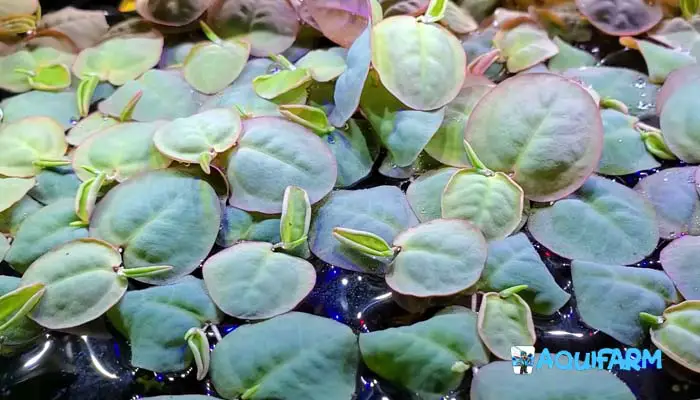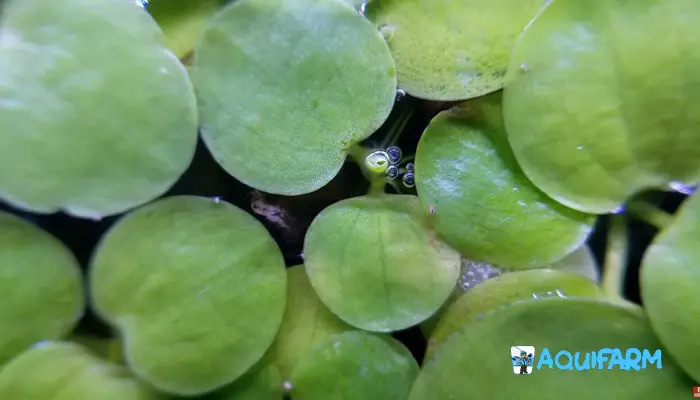Red Root Floater Vs Frogbit: All the Things in Detail
Red Root Floater and Frogbit are both floating aquatic plants commonly used in aquariums and ponds. The first one is red-toned and the latter is green. Since both of them are floaters, it’s easy to be confused about which one to pick.
Red Root Floater (Phyllanthus fluitans) is a floating shrub with vivid red roots and foliage that can blush red under strong light and lean nutrients. It’s widely used in aquascaping for its unusual color and surface coverage. Under bright lighting, it looks so striking it almost feels like fairy-land foliage.
By contrast, Amazon Frogbit (Limnobium laevigatum) is a perennial, bright green floater popular with aquascapers for its clean, natural look and long, feathery roots. It’s often cultivated as a natural shield against excess light and heat, and to reduce surface film.
Both Red Root Floater and Amazon Frogbit grow dense foliage, so they provide excellent cover for bettas, shrimp, and shy fish. So, red root floater vs frogbit—what’s my verdict?
Red Root Floater has hydrophobic leaves that shed splashes and can turn red with high light and balanced nutrients. It’s easy to handle and low-maintenance once dialed in.
Amazon Frogbit is prized in aquascaping for its lush green rosettes and tolerance of a wide range of water conditions. It reflects a natural pond vibe and adapts well to low-tech tanks.
In this article, I’ll walk you through what matters most so you can pick confidently for your tank.
Let’s get going!
Red Root Floater and Frogbit: Quick Comparison
There’s a lot of information online about Red Root Floater and Frogbit, so here’s a quick table that summarizes the key variables to make things easier.
| Particulars | Red Root Floater | Frogbit |
| Origin | Amazon River Basin, South America | Central and South America |
| Aquascape | Floater | Floater. |
| Ideal Temperature | 22 °C – 26 °C (72 °F – 80 °F) | 18 °C – 26 °C (64 °F – 80 °F) |
| Ideal pH | 6.5 – 7.5 | 6.0 – 7.5 |
| Lighting Needs | High | Medium |
Now that you’ve seen the fundamentals of Red Root Floater and Frogbit, let’s go into the specifics.
Red Root Floater Vs Frogbit: Detailed Comparison
At first glance, both plants look similar. On closer inspection, leaf texture, root structure, and growth behavior make them easy to tell apart. Knowing these details helps you choose the right plant for your setup and maintenance style.
Origin
Both species are native to the Neotropics. They may look alike on the surface, but they’re from different families and develop distinct roots and rosettes.
Red Root Floater

If you want a splash of color, Red Root Floater (Phyllanthus fluitans) is ideal. It hails from the Amazon basin and forms floating rosettes with dangling crimson roots that fish and shrimp love to explore.
The leaves float at the surface like water lettuce and duckweed, but are broader and more hydrophobic. Under high light and lean nitrate, leaves can blush red due to anthocyanin production.
This plant is widely available from aquascaping vendors and marketplaces.
The Frogbit

Frogbit (Limnobium laevigatum) is native to Central and South America and has since naturalized in parts of North America, Africa, and Australia. It produces round, glossy leaves with long, feathery roots that create beautiful shaded “curtains.”
The genus name comes from Greek for “living in lakes.” Several varieties exist, including the rarer Tiger-Striped Frogbit with faint edge striping and smaller, tighter rosettes.
There’s also American Frogbit (Limnobium spongia), a different species native to North America. It has smaller, firmer leaves and often longer, very feathery roots. Growth is slower, which suits nano tanks.
When it comes to care, Red Root Floater and Frogbit overlap, but their preferences differ in flow, nutrients, and light.
Red Root Floater
Red Root Floater prefers calm surfaces. Strong surface agitation or filter splash can stunt it or cause leaf melt. Use float rings or baffles near the outflow to keep a quiet patch for rosettes to multiply.
It appreciates a nutrient-rich water column with good micronutrients—especially iron—for color and steady growth. Moderate nitrates (5–20 ppm) and non-limiting phosphates help prevent random die-off.
Besides adding texture, it uptakes excess nutrients and trace metals via roots, helping stabilize young tanks and reduce algae pressure below.
The Frogbit
Frogbit is hardy and beginner-friendly. It tolerates a wider range of parameters and grows by sending out stolons that form new daughter plants quickly under the right conditions.
It’s easy to care for once you dial in light height and flow. Avoid leaf splash and salt creep; standing droplets can “burn” leaves. Remove browning leaves promptly to prevent rot.
Ideal Temperature
Temperature is crucial for consistency. A small heater helps you avoid cold shock and seasonal stalls.
Red Root Floater
Red Root Floater enjoys typical tropical ranges of 22–26 °C (72–80 °F). Excess heat can cause melt; many aquarists prefer LED lighting over direct sun to avoid overheating. Too cool and growth slows and color fades; prolonged chill can lead to deterioration.
The Frogbit
Frogbit is slightly more sensitive to sudden cold snaps; growth slows, leaves yellow, and health declines if temperatures drop sharply. Keep it within the same general tropical range as Red Root Floater for best results.
Because it’s from tropical regions, Frogbit tolerates a slightly broader band than some red floaters, but still performs best in warmer, stable water with minimal swings.
Ideal pH
pH stability keeps both species growing predictably and reduces melt events.
Red Root Floater
Aim for pH 6.5–7.5. Outside that range, nutrient uptake can be inconsistent and coloration suffers.
The Frogbit
Frogbit is comfortable at pH 6.0–7.5. Keep KH/GH moderate and avoid abrupt changes during large water changes.
Lighting Needs
Light powers growth and, for Red Root Floater, drives the red blush. Match intensity to your nutrient levels to avoid melt or algae.
Red Root Floater
Provide strong light for compact growth and red coloration. Too little light yields pale, leggy leaves; too much with poor nutrients can scorch. In softer water you can run slightly lower intensity; harder water often needs more intensity to look its best.
Leaves typically start green and turn pink to red under high PAR and adequate iron. With proper lighting, Red Root Floater can also produce tiny white flowers.
High-light fish like rainbowfish, gouramis, danios, and many tetras are comfortable with this plant. If your fish dislike bright light, use float rings to confine the plant and create shaded zones below.
LED fixtures are recommended because they minimize heat transfer to the surface.
The Frogbit
Frogbit rides the surface, so it’s flexible with light—thriving in medium light and tolerating low to high. Just keep fixtures high enough to avoid leaf burn.
T5/T8 or LED both work well. You don’t need lights on all the time—target 8–10 hours to balance growth and algae control.
Adaptable plant: it fits most photoperiods you run for your livestock. Just avoid extreme heat from lights placed too close to the leaves.
Read More-
Final Verdict
We’ve covered the key differences between Red Root Floater and Frogbit. With the right care, both will thrive and improve water quality by absorbing excess nutrients.
Maintain stable water parameters—temperature, pH, and light—for both species. Choose based on your goals: color pop and compact rosettes (Red Root Floater) or classic green, long roots, and wider tolerance (Frogbit). Either way, thin plants weekly so they don’t cover 100% of the surface and block gas exchange.
FAQs
How Quickly Can Red Root Floater Grow?
Red Root Floater grows at a moderate to fast pace under high light and stable nutrients (especially iron). In ideal conditions, daughter rosettes can double coverage in a few weeks.
Is CO2 Required For Red Root Floater?
No. CO2 is optional. It benefits from a balanced water column (nitrate 5–20 ppm, phosphate non-limiting, and iron/micros). Strong light without nutrients can cause melt, so keep both in balance.
Can Frogbit Be Used With Betta Fish?
Yes. Frogbit is excellent for bettas—its broad leaves and long roots create shaded, low-stress areas. Just prevent full surface coverage so oxygen exchange remains healthy and bettas can breathe easily.
Conclusion
You should now be clear on red root floater vs. frogbit. Provide conditions that mimic their tropical origins—stable warmth, moderate hardness, and steady light—and they’ll reward you with growth and nutrient uptake.
Regardless of which you choose, monitor temperature and photoperiod, thin excess plants weekly, and keep some open surface for gas exchange. Both species support a healthier micro-ecosystem for bettas, shrimp, and small community fish while adding serious visual appeal.
For me, both are great picks—use Red Root Floater for a color accent and Frogbit for classic green canopies. Enjoy building your floating “ceiling” and happy aquascaping!
- Hydroponic Farming Business Plan: Your Step-By-Step Aquaponics - December 4, 2025
- Columbia Hydroponics: Your Ultimate Guide To A Thriving Paludarium - December 4, 2025
- Rimworld Efficient Hydroponics – Bringing Sci-Fi Farming To Your - December 4, 2025
